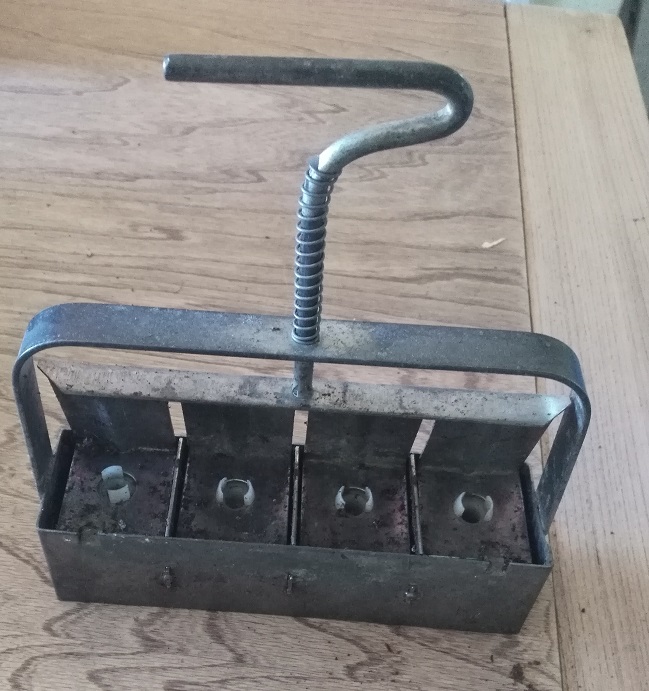How to Start Seeds on a Small Farm Scale Suzie showing how to start seeds using a soil blocker Suzie showing how to start seeds using a soil blockerStarting seeds efficiently is important for the new small farmer or market gardener. As I write this, I'm in the middle of seed starting right now for my own organic garden, so I thought I would offer a few tips about that topic for the new market grower. This is the straight poop (composted of course) about what works for us here on the farm.
Important: Get Your Seeds ASAP
Let's start out right at the beginning, i.e. ordering your seeds . . .
We often buy the next biggest quantity size up from what we need for immediate use. This will also save you money because of quantity discounts, and might save you shipping costs in future seasons. You can see some of the seed houses I recommend here. Get the right seed-starting equipment This little seed starting tool has a LOT of miles on it This little seed starting tool has a LOT of miles on it
How to Start Seeds Tip #2: Buy the right equipment. DO NOT try to use odd containers, and assorted 'found items' to start your seeds.
Buy these items in case lots whenever possible, because you will save 50% or more over the retail price. And with care, the trays and inserts are re-usable for several years. See the point about asking for a discount below as well. Foe the last few years we have used a soil blocker for seed starting. This saves on buying plastic cell inserts (economically and environmentally friendly) and in my opinion, they grow a better transplant. My 2" soil blocker works fine with my seed starting mix. A good quality one will last you for years. Another way to reduce the use of plastics is to use reusable, washable trays. Here's good market gardener seed starting bundle featuring sturdy reusable equipment. Get a good quality seed starting mixHow to Start Seeds Tip #3: Use a sterile seed starting mix. Buy Promix or similar sterile medium intended for starting seeds. Do not use 'homemade' mixes, at least for the first couple years when you are getting started.
How to Start Seeds - Scheduling
Here's how you develop a schedule for your vegetable garden plans: When you are planning when to start your garden, you need to consider your last spring frost date (LFD) for spring and summer crops, and first fall frost date (FFD) for fall crops (if you live in an area subject to frost).
Other links of interest
I'm planning to build a new greenhouse this spring. I went searching for DIY greenhouse kits; here's what I found This is a pretty good article about Urban Survival. You might also want to up your self-sufficiency game with my Homestead Book Bundle If (like me) you would rather build it than buy it, this is for you...I didn't write this one, but it's an excellent resource for the homesteader or small property owner anyway! The Self-Sufficient Backyard has literally hundreds of plans and practical tools and techniques for the serious homesteader.Written by a couple who have actually done the work. From growing food, to medicinal herbs, solar electricity, root cellaring, growing small livestock, and selling select produce as a side hustle, plus many more money-saving and money-making ideas, this book is an encyclopedia of growing and building knowledge. A must-have in your homestead library. I only write about topics I have personal experience with. The authors of The Self-Sufficient Backyard have done the same. Highly recommended! Bootstrap Market Gardening, my first Bootstrap Book, shows you step-by-step how to start-up, market and manage an organic market garden based on CSA principles. This is the information that won us the $5,000 Premier's Award for Agri-Food Innovation. But you can get it for quite a bit less. New edition includes my Garden Planner spreadsheet. Get Bootstrap Market Gardening only from New Terra Farm.
|
See Something You Like? Share!
Got questions to ask, stories to tell?
Share your organic market gardening question, or comment, or story.
Recent Articles
-
Farm grown reviews of products recommended by New Terra Farm
Dec 04, 25 06:26 AM
Find great farm and garden products in my farm grown reviews -
Best Chicken Coop and Accessories for Small Farms and Homesteads
Nov 30, 25 09:18 AM
Looking for the best chicken coop? Here are the top coops, accessories, nest boxes, and gear to build a safe, productive poultry setup. -
Community Supported Agriculture Marketing Ideas To Sell Out The Season
Nov 05, 25 05:18 AM
Authentic Community Supported Agriculture marketing ideas to grow loyalty, boost sign-ups, and sell out your CSA every year







